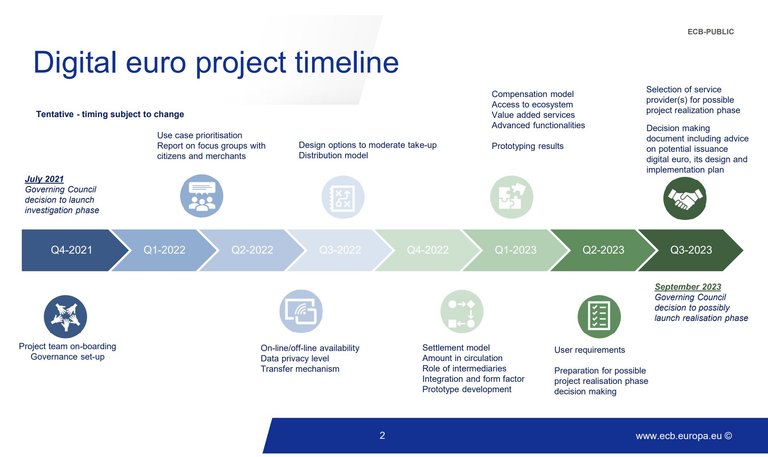
European Central Bank (ECB) board member Piero Cipollone emphasized that former U.S. President Donald Trump’s recent executive order supporting U.S. dollar-backed stablecoins could accelerate the disintermediation of traditional banks. Cipollone warned that this development underscores the need for Europe to adopt its own central bank digital currency (CBDC)—the digital euro—to remain competitive and mitigate risks to the financial system.
The ECB has reiterated its commitment to advancing a digital euro, pointing to Trump’s executive order as a pivotal moment that could reshape global financial dynamics. Signed on January 23, the order seeks to “promote the development and growth of lawful and legitimate dollar-backed stablecoins worldwide,” while establishing a regulatory framework to facilitate their adoption.
Speaking at a conference in Frankfurt, Cipollone underlined the potential global implications of the order: “The key word here is worldwide. This approach could significantly disintermediate banks by drawing clients and fees away from them. That’s why it’s imperative for Europe to accelerate its work on a digital euro.”
The Digital Euro: A Strategy to Address Growing Challenges
The ECB officially launched its digital euro project in October 2021, driven by the need to adapt to a rapidly evolving financial ecosystem. With pilot programs underway, the central bank is evaluating the practicality, scalability, and potential impact of a digital euro on the European economy. However, its adoption hinges on approval from European legislators.
A digital euro would serve as a state-backed alternative to private cryptocurrencies, particularly those issued by non-European entities. By offering a secure, inclusive, and cost-efficient payment solution, it aims to counterbalance the risks posed by the increasing popularity of private stablecoins. Importantly, it would also provide access to digital payments for individuals without traditional bank accounts, enhancing financial inclusion.
Safeguards to Prevent Banking Disintermediation
Despite its benefits, the ECB is aware of potential risks associated with a digital euro, particularly the possibility of destabilizing traditional banking systems. To mitigate these concerns, the ECB has proposed several safeguards, including:
- Holding Limits: Caps on the amount of digital euros individuals can hold to prevent large-scale capital outflows from bank accounts.
- Waterfall Mechanism: For businesses and merchants, a zero-holding policy ensures that any received digital euros are immediately transferred to their bank accounts, maintaining stability in the banking system.
- No Interest Payments: Digital euros will not accrue interest, discouraging excessive accumulation and preserving the role of banks in offering savings and credit services.

Key Drivers for the Digital Euro Initiative
Several factors underscore the urgency of the ECB’s push for a digital euro:
Adapting to Shifting Consumer Preferences
With digital payments becoming increasingly popular, the digital euro would cater to consumer demand while preserving cash as an option. This ensures the financial system remains inclusive and future-proof.Streamlining Payments Across the Eurozone
A unified digital currency would reduce transaction costs and enhance payment efficiency for citizens and businesses alike, fostering greater economic integration within the region.Strengthening European Financial Sovereignty
By reducing reliance on non-European payment providers, the digital euro would bolster Europe’s strategic autonomy in the global financial landscape, safeguarding its monetary and economic interests.

Contrasting US and EU Approaches
Trump’s executive order notably prohibits the Federal Reserve from issuing its own central bank digital currency (CBDC), signaling the U.S. government’s preference for a market-driven approach. This policy favors private stablecoin issuers such as Circle, Tether, Ripple, and PayPal, allowing them to dominate the digital currency space.
In contrast, the ECB advocates a hybrid model that leverages public-private collaboration. ECB Executive Board member Ulrich Schaaf criticized the fragmented nature of private-sector payment solutions, noting that they often lack pan-European interoperability. He argued that a digital euro issued by the central bank would address these shortcomings by offering a unified, integrated payment system.
Collaborative Implementation
While the digital euro would remain a liability of the ECB, its deployment would involve private-sector intermediaries. Schaaf explained: “Distributors will primarily be payment service providers, including banks. They will handle customer relations, exchanges, and additional services linked to the digital euro. This creates opportunities for banks to innovate and develop new products on top of the digital euro infrastructure.”
Looking Ahead
As the ECB continues its exploratory phase, the development of the digital euro will be closely monitored. Balancing innovation with stability remains a key challenge, as the central bank aims to create a robust digital currency that aligns with Europe’s economic priorities while safeguarding its financial system from disruption.
By addressing both the opportunities and risks posed by the rise of stablecoins, the ECB seeks to position the digital euro as a cornerstone of Europe’s financial future, ensuring it remains competitive in a rapidly changing global landscape.
Congratulations @mikezillo! You have completed the following achievement on the Hive blockchain And have been rewarded with New badge(s)
Your next target is to reach 12000 upvotes.
You can view your badges on your board and compare yourself to others in the Ranking
If you no longer want to receive notifications, reply to this comment with the word
STOPCheck out our last posts: